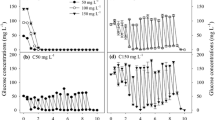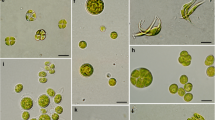Abstract
Autotrophic and heterotrophic growth characteristics of a nano-flagellate were investigated. The flagellate,Ochromonas sp., was isolated from the northern Baltic Sea. Autotrophic growth was poor. Axenically pregrown flagellates did not increase significantly in cell number during incubation in different inorganic media. The number of flagellates remained constant 3–5 weeks in cultures kept in the light (100μmol m−2 sec−1), whereas in the dark, a high mortality rate was found. Uptake of inorganic14C into an acid-stable fraction indicated thatOchromonas had a functional photosynthetic apparatus. Heterotrophic growth in both liquid medium and medium containing bacteria was rapid. The maximum growth rate corresponded to a generation time of 5.3 hours. Light had no effect on heterotrophic growth. Cells pregrown onEscherichia coli minicells survived without additional bacteria as food when kept in the light, but rapid death occurred in darkness. In conclusion, heterotrophy is the major mechanism to support growth in this species ofOchromonas, but under poor environmental conditions photoautotrophy might be a strategy for survival rather than growth.
Similar content being viewed by others
References
Andersen P, Fenchel T (1985) Bacterivory by microheterotrophic flagellates in seawater samples. Limnol Oceanogr 30:198–202
Andersson A. Larsson U, Hagström Å (1986) Size-selective grazing by a microflagellate on pelagic bacteria. Mar Ecol Prog Ser 33:51–57
Andersson A, Lee C, Azam F, Hagström Å (1985) Release of amino acids and inorganic nutrients by heterotrophic marine microflagellates. Mar Ecol Prog Ser 23:99–106
Bertani G (1951) Studies on lysogenesis. I. The mode of phage liberation by lysogenicEscherichia coli. J Bacteriol 62:293–300
Bird DF, Kalff J (1986) Bacterial grazing by planktonic lake algae. Science 231:493–495
Caron DA (1983) Technique for enumeration of heterotrophic and phototrophic nanoplankton, using epifluorescence microscopy and comparison with other procedures. Appl Environ Microbiol 46:491–498
Davis PG, Caron DA, Johnson PW, Sieburth JMcN (1985) Phototrophic and apochlorotic components of picoplankton and nanoplankton in the north Atlantic: geographical, vertical, seasonal and diel distributions. Mar Ecol Prog Ser 21:15–26
Doddema H, Van Der Veer J (1983)Ochromonas monicis sp. nov. A particle feeder with bacterial endosymbionts. Cryptogam Algol 4:89–97
Estep KW, Davis PG, Keller MD, Sieburth JMcN (1986) How important are oceanic algal nanoflagellates in bacterivory? Limnol Oceanogr 31:646–650
Fenchel T (1982a) Ecology of heterotrophic microflagellates. I. Some important forms and their functional morphology. Mar Ecol Prog Ser 8:211–223
Fenchel T (1982b) Ecology of heterotrophic microflagellates. II. Bioenergetics and growth. Mar Ecol Prog Ser 8:225–231
Fenchel T (1982c) Ecology of heterotrophic microflagellates. III. Adaptions to heterogeneous environments. Mar Ecol Prog Ser 9:25–33
Fogg GE (1977) Aquatic primary production in the Antarctic. Phil Trans R Soc Lond B 279: 27–38
Ford JE (1958) B12-vitamins and growth of the flagellateOchromonas malhamensis. J Gen Microbiol 19:161–172
Hagström Å, Andersson A, Öquist G (1983) Algal and bacterial production in a coastal area (Norrbyn) of the northern Bothnian Sea. Aquilo Ser Zool 22:131–137
Hagström Å, Larsson U (1984) Diel and seasonal variation in growth rates of pelagic bacteria. In: Hobbie JE, Williams PJLeB (eds) Heterotrophic activity in the sea. Plenum, New York pp 249–262
Hannah FJ, Boney AD (1983) Nanophytoplankton in the firth of Clyde, Scotland: seasonal abundance, carbon fixation and species composition. J Exp Mar Biol Ecol 67:105–147
Holligan PM, Harris RP, Newell RC, Harbour DS, Head RN, Linley EAS, Lucas MI, Tranter PRG, Weckley CM (1984) Vertical distribution and partitioning of organic carbon in mixed, frontal and stratified waters of the English Channel. Mar Ecol Prog Ser 14:111–127
Huber-Pestalozzi G (1941) Das Phytoplankton des Süsswassers. Systematik und Biologie. In: Thineman A (ed) Die Binnengewässer 16. Teil 2:1. E Schweizerbart'sche Verlagsbuchhandlung, Stuttgart, pp 156–177
Joint IR, Pomroy AJ (1983) Production of picoplankton and small nanoplankton in the Celtic Sea. Mar Biol 77:19–27
Kennedy N, Beutin L, Achtman M (1977) Conjugation proteins encoded by the F sex factor. Nature (London) 270:580–585
Larsson U, Hagström Å (1982) Fractionated phytoplankton primary production, exudate release and bacterial production in a Baltic eutrophication gradient. Mar Biol 67:57–70
McCarthy JJ, Rowland Taylor W, Loftus ME (1974) Significance of nanoplankton in the Chesapeake Bay estuary and problems associated with the measurement of nanoplankton productivity. Mar Biol 24:7–16
McManus GB, Fuhrman JA (1986) Bacterivory in seawater studied with the use of inert fluorescent particles. Limnol Oceanogr 31:420–426
Morgan K, Kalff J (1975) The winter dark survival of an algal flagellateCryptomonas erosa (Skuja). Verh Internat Verein Limnol 19:2734–2740
Myers J, Graham J-R (1956) The role of photosynthesis in the physiology ofOchromonas. J Cell Comp Physiol 47:397–414
Müller-Haeckel A (1985) Shade-adapted algae beneath ice and snow in the northern Bothnian Sea. Int Revue Ges Hydrobiol 70:325–334
Perry MJ, Talbot MC, Alberte RS (1981) Photoadaption in marine phyto-plankton: response of photosynthetic unit. Mar Biol 62:91–101
Phinney DA, Yentsch CS (1985) A novel phytoplankton chlorophyll technique: toward automated analysis. J Plankton Res 7:633–642
Pringsheim EG (1952) On the nutrition ofOchromonas. Q J Microsc Sci 93:71–96
Rowe R, Todd R, Waide J (1977) Microtechnique for most-probable-number analysis. Appl Environ Microbiol 33:675–680
Samuelsson G, Richardson K (1982) Photoinhibition at low quantum flux densities in a marine dinoflagellate (Amphidinium carterae). Mar Biol 70:21–26
Sieburth JMcN, Davis PG (1982) The role of heterotrophic nanoplankton in the grazing and nurturing of planktonic bacteria in the Sargasso and Caribbean Seas. Ann Inst Oceanogr Paris 58:285–296
Sherr BF, Sherr EB, Fallon RD (1987) Use of monodispersed, fluorescently labeled bacteria to estimate in situ protozoan bacterivory. Appl Environ Microbiol 53:958–965
Sokal RR, Rohlf FJ (1981) Biometry. Freeman and Co, New York
Steeman Nielsen E (1952) The use of radioactive (14C) for measuring organic production in the sea. J Cons Perm Int Explor Mer 18:117–140
Strickland JDH, Parsons TR (1972) A practical handbook of seawater analysis. Fisheries Research Board of Canada, Ottawa, Canada
Vogel HJ, Bonner DM (1956) Acetylornithinase ofEscherichia coli: partial purification and some properties. J Biol Chem 218:97–106
Wikner J, Andersson A, Normark S, Hagström Å (1986) Use of genetically marked minicells as a probe in measurements of predation on bacteria in aquatic environments. Appl Environ Microbiol 52:4–8.
Author information
Authors and Affiliations
Rights and permissions
About this article
Cite this article
Andersson, A., Falk, S., Samuelsson, G. et al. Nutritional characteristics of a mixotrophic nanoflagellate,Ochromonas sp.. Microb Ecol 17, 251–262 (1989). https://doi.org/10.1007/BF02012838
Issue Date:
DOI: https://doi.org/10.1007/BF02012838




